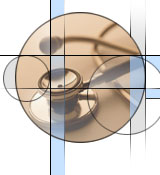





Hydrocephalus means water on the brain. It was first described by Hippocrates, who also suggested various treatments for the condition
The brain and spine are hollow and contain fluid, cerebro-spinal fluid (csf). The cavities in the brain containing the fluid are known as ventricles.
This fluid also surrounds the brain and spine. The csf protects the brain from impact on the skull and also nourishes the brain. The adult brain produces around 500ml of fluid per day, however the capacity for the fluid in the brain is only 125ml. Thus the fluid is produced and circulates around the brain and then is reabsorbed into the blood. The brain keeps the situation of fluid production and re-absorption in balance so that there is a constant amount of fluid around the brain. Any mechanism which disrupts this balance can cause too much fluid within the brain. This is known as hydrocephalus. In general terms hydrocephalus can occur when too much fluid is produced, the circulation is fluid is blocked, or not enough fluid is reabsorbed into the blood..

Hydrocephalus occurs in 1-1.5% of the population.

Congenital Causes
- Aqueduct stenosis
- Chiari 1 and 2 malformation (seen in patients with spina bifida)
- Dandy Walker Syndrome
- Rare X-linked disorders
Acquired Causes
- Infection (usually as a consequence of meningitis)
- Bleeding (bleeding from prematurity, intraventricular haemorrhage)
- Sub arachnoid Haemorrhage
- Tumours (colloid cyst, posterior fossa tumour)
- Spinal tumours

The symptoms of hydrocephalus are in part dependant on the age of the child. In the young child and baby the child's head may enlarge much more so that the face. The child may be irritable and have poor head control. The soft spot (fontanelle) in the front of the child's head may be full and bulging. The veins of the scalp may be engorged. Some children develop the sun-setting sign, where their eyes tend to be looking downwards.
Older children and adults may develop a headache, nausea, vomitting, some can become drowsy and even go into a coma.

Where the diagnosis is suspected a cause should be sought.
In the ante-natal period the diagnosis may be made by ultrasound scan of the baby while still in the womb. A MRI scan of the foetus can also be performed.


Treatment may involve treatment of the cause of the hydrocephalus, i.e. removal of a tumour which may be blocking the fluid chambers.
Most patients with symptomatic hydrocephalus need a cerebral spinal fluid (csf) diversion procedure. The options are to divert the fluid from the head into another body cavity (abdomen or chest) or re-route the flow of fluid within the brain.

Diversion is performed by inserting a tube and a valve into the fluid chambers and then running a further tube from the valve into the appropriate body cavity. This system is called a shunt, and is most commonly placed from the ventricle to the peritoneum (ventriculo-peritoneal shunt).
There are many different shunts available. In simplistic terms a shunt is a tube running from the ventricle attached to a valve and then into the abdomen. When the fluid volume in the brain increase, the valve opens and fluid drains away, leaving the pressure in the brain at a normal level.
Some patients drain too much fluid or too little fluid. These patients can benefit from a programmable shunt when the opening pressure can be altered.
Complications of shunts
Shunts can become infected (2-5%) and can block. 80% of shunts will cease to function within 20 years. Complications can also arise from over drainage, and some of these may be avoided by programmable valves. If the shunt ceases to function then a replacement will be needed.
Third Ventriculostomy
In some cases of hydrocephalus fluid can be re-routed within the brain. A new hole is made within the brain to bypass the obstruction in the brain. This procedure is called a Neuroendoscopic Third Ventriculostomy (NTV).
Only certain patients are suitable for a Ventriculostomy. These patients will be shunt free if the procedure is successful. The patients who are most suitable include those who are older than 6 months of age and have a blockage causing the hydrocephalus (aqueduct stenosis). Ventriculostomy may also be performed in certain patients who present with a shunt which has malfunctioned. Every patient presenting with hydrocephalus should be considered for a third ventriculostomy. Many will however be unsuitable. The overall success rate depends on the selection of the patients. The success rate is around 75%.
Complications of Third Ventriculostomy
The procedure may fail. Damage can occur to the blood vessels (basilar artery, usually fatal). Damage can also occur to the memory circuits, especially in inexperienced hands. Third ventriculostomy has revolutionised hydrocephalus form some patients.
Summary
Hydrocephalus is a common and often difficult problem to treat. With changes in technology of the valves, anti-bacterial catheters and endoscopes the treatment is improving. My view is that patients with hydrocephalus must be managed by a team who specialises in the treatment of these particular patients. Experience in treating the disease, experience in shunt insertion and experience in endoscopy all improve the results for the patients.
